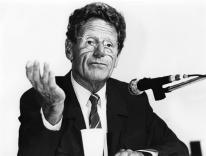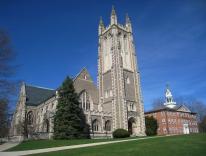
The opening sentence of Langdon Hammer’s fine, wholly definitive biography of the writer James Merrill, quotes his riposte to the complaint of a professor friend who reminded him, “Some of us have to work for a living.” Merrill’s comeback was simple and conclusive: “I live to work.” Since his death in 1995, that work has been amply displayed in three large volumes of poems, a volume of collected prose, and a volume of novels and plays. By far the most important of these are the poems, all nine hundred pages of them, edited by his close friends and fellow writers, J. D. McClatchy and Stephen Yenser. As these volumes appeared, Hammer was at work for at least fifteen years in putting together an exhaustive account, alive on every page, of the life and work of his subject. The account succeeds in giving devoted, intelligent attention to Merrill’s writings—mainly his poems—as it does to the life that went into this work. Hammer’s nine-hundred-plus-page book is a load, hard to hold on one’s lap, but it is executed with such loving, assiduous care that one can’t imagine it ever needing to be done again,
Hammer met Merrill when, as a professor at Yale, Hammer was invited to drive the poet from his house in Stonington, Connecticut, to a memorial reading for Wallace Stevens at the University of Connecticut. On the road he found Merrill’s voice compelling, “suave, modulated, surprisingly low and deep, vaguely Southern or ‘mid-Atlantic’ like a movie actor’s from the 1940s.” In its gravity and modulation, Hammer’s own voice on the page is ideal to convey the “shrewd, ironic wit” he finds everywhere in Merrill’s work.
My own first encounter, decades ago, with this poet’s unmistakable voice came when he read his poetry to an audience of students and teachers in Amherst College’s largest public room. Without, it seemed, ever raising his voice, Merrill made his lines feel perfectly enunciated, clearly to be followed, if only I could have kept up with their fast-evolving individual figures. He read aloud something recently written, “The Thousand and Second Night,” a difficult poem in five sections of varying length, whose fourth part consists of an English professor “teaching” the poem’s first part to his college class. Merrill’s professor describes how the “rough pentameter / Quatrains” give way “to three / Interpolations, prose as well as verse.” After his exposition he entertains a couple of questions and concludes the section as follows:
Yes please? The poet quotes too much?
Hm. That is
One way to put it. Mightn’t he have planned
For his own modest effort to be seen
Against the yardstick of the “truly great”
(In Spender’s phrase)? Fearing to overstate
He lets THEM do it—let’s their words,
I mean,
Enhance his—Yes, what now? Ah. How
and when
Did he “affirm”? Why, constantly. And
how else
But in the form. Form’s what affirms.
That’s well
Said, if I do—[Bells ring]. Go, gentlemen.
Although I followed this sequence more successfully than earlier allusive and complicated ones, it wasn’t until it was published that I realized the astonishing mixture of ear-and-eye coordination it demands. Its ABBA rhyme scheme and iambic pentameter are maintained scrupulously; but individual lines are interrupted by parenthesis, dashes, questions, brackets, and little words like “Hm” and “Ah” that don’t make a splash in most poems. The poet is teasing the professor who has just finished analyzing (no doubt very well) that poet’s latest effort. But print won’t do to suggest the audible effects produced by question and answer, momentary puzzlement, momentary satisfaction in having found a good way to put it, with an incomplete “well / Said if I do—” cut off by the end-of-class bell.
“The Thousand and Second Night” is from Merrill’s fourth book of poems, Nights and Days, published in 1966. Among its contents are other longish, personally infused poems, such as “The Broken Home” about his parents and “Days of 1964,” about living in and returning to Greece. Yet his early poems were dauntingly abstract, “objective” or “symbolic,” asking for a very clever reader indeed. In reviewing his first collection, Louise Bogan, a critic to be taken seriously, called his poems “impeccably written, but everything about them smells of the lamp: they are frigid and dry as diagrams.” So Merrill’s achievement in what Hammer calls “roughening the verbal texture of his verse,” resulted in a “sociable, middle style” that is perhaps the most surprising and gratifying turn in his poetic career. Using devices like interruption and revision, replacing the symbolic scenes of early poems with specific, lived experiences, while rejecting a unified lyric voice in favor of many tones and speakers, made his poetry “funny, more dynamic.” What is commendable about this judgment is not just its truth, but that the truth emerges from a full seven-page consideration of “The Thousand and Second Night.” Comparable attention to many other Merrill poems explains why this biography is almost a thousand pages long.
***
In beginning these comments with Merrill’s art, I don’t mean in any way to suggest that Hammer has been less than comprehensive in his sensitive narration of the poet’s life. To take but one example, there is “The Orchard,” the Merrill summer home in Southampton, Long Island, where James’s parents, the financier Charles Merrill and his second wife Hellen, entertained lavishly. Designed by the famous architect Stanford White, the Orchard is described within an inch of its opulent life, as if the biographer were thoroughly intimate with it, as he no doubt was. As an example of the scale of entertainment that went on there we are given a look at “Sunday lunches…preceded by highballs, accompanied by new wines with each course, and polished off with cordials—all on top of whatever had been tossed down the night before and would be consumed in the evening to come.” In the first of the son’s autobiographical poems, the marriage between “Charlie” and Hellen is called, wittily, “a marriage on the rocks” (remember those highballs). Merrill’s parents separated in 1953.
By this time their son had completed his academic education at Lawrenceville School and Amherst College. At Lawrenceville he met another writer in the making, the underrated novelist and essayist Frederick Buechner, who became his lifelong friend. At one point they read aloud to each other Henry James’s late novel The Wings of the Dove. As a freshman at Amherst, his father’s alma mater, Merrill discovered Proust and would later write his senior honors thesis on À la recherche du temps perdu. He also fell in love with one of his professors, Kimon Friar, a Greek whose early influence on Merrill was profound and who sparked the poet’s long fascination with Greece. In the same year that Merrill’s parents divorced, he met David Jackson, who became his partner for life, though not to the exclusion of other lovers. When he was thirty, Merrill published a novel “about” his relationship with father and family that his mother Hellen called “inconsiderate, disloyal, and downright callous.” In any case, The Seraglio is not much fun to read, and the pages Hammer spends on it seem excessive.
Merrill’s “breakthrough” volume of poems came in 1962 with Water Street, the title taken from the street Merrill and Jackson lived on when they bought their first house in Stonington, Connecticut. Its turn toward autobiography, as seen especially in the opening and closing poems of the book, “An Urban Convalescence” and “A Tenancy,” showed the influence, in Hammer’s judgment, of Robert Lowell’s Life Studies, published in 1959. Hammer reports that Merrill “resented” Lowell’s increasing dominance of the poetry scene but, like many other American poets, the younger poet was not immune to the new possibilities Lowell’s work opened up. Instead of the abstraction Merrill had been prey to, Life Studies suggested a mode of “comic self-dramatization” that would be Merrill’s most attractive mode of writing throughout the rest of his career. At the close of “A Tenancy,” the last poem in the book, “one foot asleep,” Merrill “hops” to welcome some friends who have come to visit, inviting them to sit. The poem ends with three rhymed stanzas rather than the freer verse previously used. Its final three lines—“If I am host at last / It is of little more than my own past. / May others be at home in it”—is a nice example of what Hammer cleverly calls “getting his metrical feet in working order”; these final stanzas show how, for Merrill, “‘closed’ form would be his means to openness.” Despite Ezra Pound’s effort to “break the pentameter” (Pound’s phrase), and the practice of poets as different as T. S. Eliot and William Carlos Williams, the pentameter had and would continue to be a good friend to Merrill: “No other meter will quite do,” he declared in the face of the now-established dominance of free verse in the 1960s and beyond.
***
This biography contains so many instances of Merrill’s brilliant, always enlivening wit that a reviewer can’t keep up with them. His opera-going experience, begun at age twelve with a season ticket to the Met, is invigoratingly capsuled in “Matinees,” one of a number of “opera” poems: “The point thereafter was to arrange for one’s / Own chills and fever, passions and betrayals, / Chiefly in order to make song of them.” Merrill was the greatest rhymer since Pope and a wicked anagram-maker, often of a “naughty” nature—turning, for example, “Marcel Proust” into “pearl scrotum.” But for all the sociable humor of his later poems, the difficulty of Merrill’s poetry shouldn’t be underestimated—anyone that skilled at anagrams is unlikely to be easily understood. Wallace Stevens, one of Merrill’s poetic heroes, famously declared that “the poem must resist the intelligence almost successfully.” More than one of Merrill’s poems is still resisting my intelligence successfully. In admitting defeat as I once more return to “From the Cupola,” or “Santorini: Stopping the Leak,” or “Clearing the Title,” or The Changing Light at Sandover (the product of evenings spent at the Ouija board), I think that only the critic Helen Vendler can fully explicate them. Yet with Merrill there is always the sense of a continuity of figure and argument in the service of some overall pattern of meaning. This sense—however much one keeps failing to master particular moments in it—distinguishes Merrill, to his credit, from his prolific contemporary John Ashbery, whose immense output may have something to do with the fact that he doesn’t bother with pentameter or rhyme.
A younger poet and admirer of Merrill, Alfred Corn, put it shrewdly when he said that “Merrill could make anything say more than it said.” (Think of those anagrams.) “There was always a subtext—he had an ability to make the material world allegorical.” A beautiful instance of this, and perhaps my favorite moment in any Merrill poem, occurs in “Up and Down.” In this poem he and his mother descend into the “inmost vault” of “Mutual Trust,” where she proposes to give her son an emerald ring that Merrill’s father had given her when their son was born. She offers it to him: “For when you marry. For your bride. It’s yours.” The poem ends in a way that is both extremely poignant and extremely witty—the way so many of Merrill’s poems respond to the world. Presented with the ring,
I do not tell her, it would sound theatrical,
Indeed this green room’s mine, my very life.
We are each other’s; there will be no wife:
The little feet that patter here are metrical.But onto her worn knuckle slip the ring.
Wear it for me, I silently entreat,
Until—until the time comes. Our eyes meet.
The world beneath the world is brightening.
Here the promise of “A Tenancy” is fulfilled, that of playing host to his own past and fulfilling the wish, “May others be at home in it.”
Please email comments to [email protected] and join the conversation on our Facebook page.
Share
Previous Story
Runyon's Way
Next Story
An Unlikely Union


